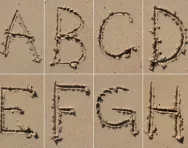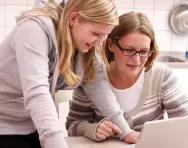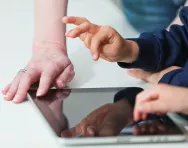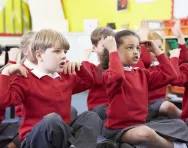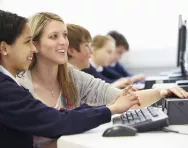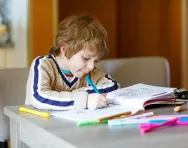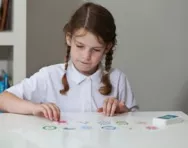The classroom of the future: back to school 2026
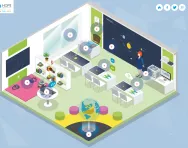
Just ten years from now primary-school classrooms might seem as unfamiliar to us as a Victorian schoolroom is.
“2026 might sound like a long way away, but technology is evolving rapidly,” says Simon Nutt from Hope Education. “It won't be long before our children are coming home to tell us that they have a regular rotation on a programming workstation, or that their homework is a collaborative exercise with instructions outlined in the Cloud.”


Start a unique learning programme!
- Weekly programme for each school year
- Worksheets sent direct to your inbox
- Keeps your child's learning on track
But what will these technological developments look like, and what will they mean for our children? Here are few examples of the kinds of things we can expect to see in school environments in the next decade.
Classroom of the future development: interactive walls
When we were at school, chalk boards were the norm. If you're young enough, you might even remember overhead projectors with acetate sheets, followed by an early foray into wipeable whiteboards. But times have changed; with the rise of tablets and smartphones, old-fashioned boards will soon be replaced with something more akin to the touch-screen technology you have in your pocket.
A highly interactive LCD wall will deliver key learning points, keep children engaged and allow for multiple children to touch the screen at once. This facilitates 'active learning', a skill that encourages a positive and proactive attitude towards education.
In fact, it's possible that these interactive walls could be operated by children not only in their classroom, but by children from classrooms all over the world with similar technology installed. Imagine: your child could share their understanding of English language with students from elsewhere on the planet, helping to teach pupils studying in places like China, India and Japan, and, in return, strengthening their command of their native tongue and deepening their literacy and communication skills.
Classroom of the future development: interactive desks
School children of the future will get to benefit from touch-screen technology at their own desks, too. Individual interactive desks mean that no single child will get to 'monopolise' the interactive wall. This is an important consideration for effective learning in the classroom of the future, as Professor Liz Burd of Durham University explains. "Certain sets of students who happen to be nearest the interactive [wall], can dominate it,” she says, but interactive desks ensure “fair and equal access” to learning so that children can complete the tasks set by their teacher.
Similarly, according to Dr Emma Mercier (Research Associate at Durham University), interactive-screen technology encourages children to engage in learning for themselves. “They're coming into a world where there's more knowledge being created than we will ever be able to teach them at school,” says Mercier, “so they need to learn how to organise knowledge for themselves, and how to continue learning throughout their lifetimes.” A solid understanding of how to access, interpret and utilise information displayed on interactive desks like these will stand our children in good stead for the future, and echoes how we already use personal technological devices in our everyday lives.
Worried that all this screen time is going to damage our children's social and communication skills? Professor Burd argues that this kind of technology is only going to help. “It's a social pedagogy... we're using the process of collaboration, and through individual students having to explain their work to other students [they're] improving the depth of understanding of the materials they're learning.”
Classroom of the future development: holograms
How did you learn about what the inside of a planet looks like, or the structure of the human body? Did you learn it from a static, uninspiring image in a textbook that you struggled to translate into something you could actually imagine and understand? Our children are likely to have a very different experience, benefitting from the advancements in holography and learning from 3D images beamed into the centre of their classrooms.
In fact, some people believe that the next step for holography in education will be to use holographic telepresence. This is going to allow our children to benefit from 'guest speakers' from all over the world being present in the classroom, enabling them to learn directly from the world's most exciting and inspiring people, such as NASA astronauts or famous historical figures from the past, kept alive in holographic form for the benefit of future generations.
Classroom of the future development: 3D printers
Another technology that children of the future are going to experience is the use of 3D printers in their classrooms. Teachers will be able to use 3D printers to literally bring theoretical, abstract ideas to life in tangible form, making learning effective and plenty of fun. For instance, difficult ideas to grasp such as DNA structures and molecular make-ups can be produced using a 3D printer, aiding understanding by giving students something to pick up, hold and examine.
3D printers are also going to allow our children to create prototypes of their work: an exciting prospect for pupils studying art or engineering, encouraging them to pay attention to fine details and have a real understanding of whether or not their ideas are practically achievable.
Classroom of the future development: virtual reality
The most exciting future education innovation of all? The use of virtual reality in the classroom. Motivating children to learn means tapping into their imaginations, adding value and feeding an innate curiosity, and nothing does this as well as virtual reality. Virtual reality is often used to teach pilots how to fly planes, or to prepare soldiers for combat; by 2026, it's thought that it will be used to deliver an array of learning materials to children.
Aside from the obvious benefit of it being engaging and fun (which is why virtual reality is currently making waves in the gaming industry), it will really help to deliver key learning points and deepen your child's understanding of a subject. It does this by placing children in situations that they simply couldn't hope to experience in the classroom, meaning that, when exploring battlefield trenches or walking the dark halls of a castle, children don't just read about history, they 'become' historians.
Taking in a 360-degree view of sights, sounds (and potentially even smells at some point in the future!), children get to travel to places that are far beyond the reach, budget or health and safety standards current school trips can aspire to.
Moreover, virtual reality addresses a key challenge to getting children engaged at school: why do they have to learn particular subjects? Virtual reality solves this by pairing cutting-edge technology with exciting game-design principles, incorporating motivational elements like a strong narrative, problem solving, consequences and rewards. For example, learning about 'best practices' in a science laboratory is infinitely more engaging when students can work their way around a virtual lab, meeting learning objectives to progress the story further and 'diagnose' a fictional medical problem.
Back to school 2026
So, in ten years' time, don't be surprised if your child comes home to tell you that they've spent the day digging in an archaeological site in Egypt while wearing a headset, or learnt about the climate of the Himalayas by walking their way around a hologram projection of a mountain range. Before break they might be found fiddling with the inside of a NASA space craft wearing a head mounted display and data glove; after lunch they might run between their interactive walls and desks, 3D printers and hologram machines to learn times tables using the very latest tools.
Sign us up to go back to primary school when it happens!


Give your child a headstart
- FREE articles & expert information
- FREE resources & activities
- FREE homework help

